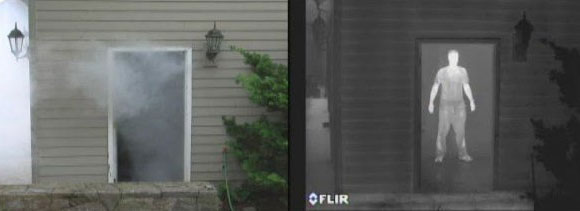Firefighting Thermal Camera Applications
Thermal technology used in firefighting saves lives. A firefighter armed with a thermal camera can see through choking darkness, detect the hottest parts of a fire and even detect the body heat of trapped individuals. Many of these units are helmet-mountable as well, allowing the firefighter to see in thermal without using their hands.
As thermal cameras become more and more affordable due to innovations in the technology, the units are becoming more common in applications where the excessive price of the cameras previously meant not many units could be purchased. Thankfully the cost of thermal cameras has gone down signficantly in recent years, leading to many bodies such as the police and firefighters adopting the thermal camera as part of their kits.
The thermal camera is an almost invaluable tool for use in firefighting applications; the units can be adapted for a wide variety of uses ranging from helping firefighters pick their way through buildings to setting up comprehensive control systems where a designated professional can view data from a helmet-mouted thermal imaging camera to give firefighters advice on the best course of action in real-time.
Firefighting thermal imaging systems can either be used held in the hands by firefighting professionals or alternatively can be clipped onto a helmet to provide easy access to a thermal view. Having this technology enables a firefighter to see through such things as heavy smoke and can even be used to detect the body heat of trapped people.
The applications don't end there though; firefighters can also use the thermal camera to detect thermal hotspots and make informed decisions on the progress of a fire. This enables the fire professionals to actively predict how the fire will spread, allowing them to take precautions and remove the fire before it causes more damage to properties or lives.
Since a firefighter's work often extends beyond just putting out fires, the thermal camera also proves to be an invaluable tool in various other applications as well. The next section of this page outlines some of the uses of thermal imaging technology deployed by use by firefighting professionals.
Early Course-of-Action Plotting
Although firemen are trained experts who know what they're doing when it comes to dealing with fires, the fact remains that fire can be an unpredicatable and extremely dangerous force. Utilising a thermal imaging camera before sending firemen into a property allows a commander and his team to plot the best course of action to tackle the blaze; allowing them to determine the fire's starting point, potential ventilation spots and can even be used to spot thermal signatures of humans.
This early planning means firemen are not rushing blind into an application, but are instead taking the best course of action to control the fire in question.
Ventilating a Fire
An effective method of eliminating a fire is to apply the use of horizontal ventilation. The use of a thermal camera in this application allows the user to determine first of all where the fire's beggining is (or 'seat'). This spot can then be effectively be ventilated by determining where in the structure might be suitable for opening up for ventilation purposes by spotting easily cuttable areas or weak areas of the property that can be exploited. It can also help the firefighter determine if structural beams, which might interfere with ventilation work, are present.
Seeing Through Smoke
Perhaps one of the greatest benefits of thermal cameras used in firefighting applications is the cameras' ability to see completely through even extremely thick smoke. Since a thermal camera doesn't detect visible light and instead works by detecting IR radiation, the smoke present in a room does not register on the camera's system, thus allowing the user to see through even the most choking smoke to detect trapped individuals or just to navigate safely through an area.
If a person is present in a smoky environment, they could be extremely hard to detect if a thermal camera is not used. A person's body heat is presented very distinctly on a thermal camera, so when using this device in a smoky environment the camera ignores the effects of the smoke and can easily detect the person's body heat.
The following image example from FLIR shows this technology in action:

As can be seen here, the thermal camera used can not only see through the smoky haze; it is also capable of displaying the hidden person by completely ignoring the effects of darkness as well. This makes the thermal imager an essential tool for navigating through difficult applications and ensures the lives of firefighters are in safer hands at all times.
Reignition Control
Something as simple as a missed spark could be the cause of a put-out fire suddenly reigniting. Once a fire has been extinguished it is highly recommended that firefighters use a thermal imaging system to scan the area that the fire was present in thoroughly; doing so allows the user of the camera to detect left-over hotspots and various other aspects that could cause the fire to suddenly start once more.
Some thermal cameras also contain a laser pointer that can be used in combination with this mode, allowing the thermal camera user and another fire professional wielding a hose to tackle the reignition potential sections of the fire in a safe and contolled manner.
Firefighting Thermal Camera Range
Take a look at the available firefighting thermal imaging cameras we have available at PASS-Thermal.co.uk:

